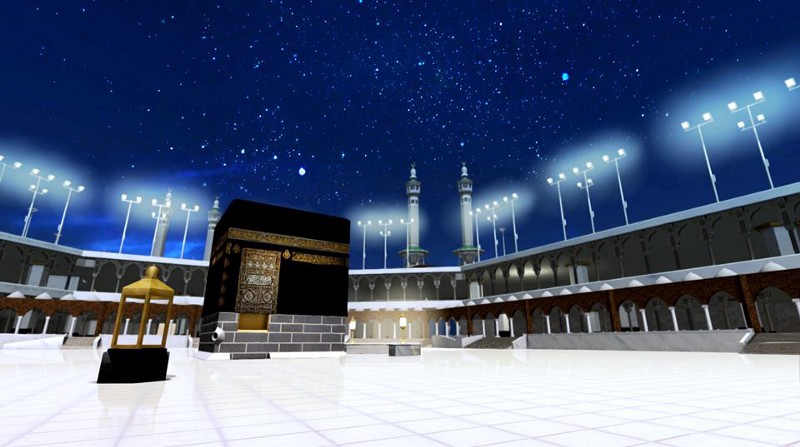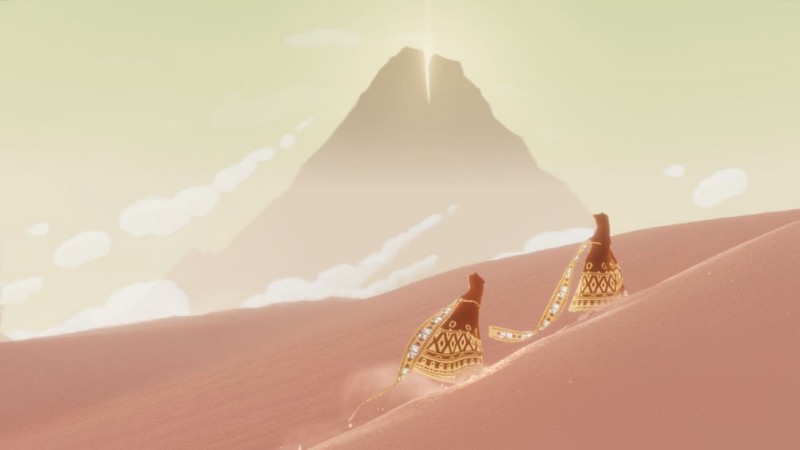

For Muslims currently living in the U.S., the idea of undertaking a pilgrimage to Mecca has become a freshly perilous one. They could well be forbidden from reentering Trump’s newly fortified America. It’s possible that’s not the only hindrance, though. Some might be unable to embark on a pilgrimage because they lack the physical capability to climb a mountain, the financial capacity to travel, or simply the time to spare. In recent years, an affordable and accessible solution has surfaced–the virtual pilgrimage.
Missing out on a trip to Mecca is more than a mere inconvenience. Every able-bodied Muslim is called to visit the city at one time in their life via an obligatory pilgrimage known as the hajj. There, at the center of the city, which only Muslims may enter, they’ll find The Great Mosque of Mecca. And inside that, the Kaaba, a compact but grand building toward which the five-times daily ritual of Salah prayers must be performed.
The hajj is one of the five pillars of Islam, and approximately two million Muslims worldwide participate annually. Like many pilgrimages of other faiths, the hajj often serves as a rite of passage, timed to coincide with life events such as adulthood, marriage, a career change, retirement, or illness. In some cases it is used as an initiation for new converts to Islam. Others take the pilgrimage in the hope of spiritual rejuvenation after a personal crisis or heartbreaking loss.
While a cottage industry has sprung up to offer disabled people the chance to undertake the hajj, for those too sick or unable to afford the cost of the journey, a freely available smartphone application offers a portal to an otherwise inaccessible city. Mecca3D allows anyone, of any faith, at any time, to enter the city’s walls and tread its marbled floors.

It’s the creation of Bilal Chbib, who founded the independent game studio Brainseed in Germany in 2013. While Mecca3D grew out of a personal curiosity, it’s now become something of greater ambition. “The idea kept haunting me,” Chbib says. “That’s why I knew I had to start work on it.”
Inside the 3D-rendered scenery, birds chirrup in the boiling sun. A cast of animated characters meander and pray. Some sit carefully listening to sermons. It looks every inch like an aging PlayStation game, all crude textures plastered to building blocks. A newer version that includes a more detailed city, which Chbib hopes will earn endorsement from the Saudi Arabian Ministry of Religious Affairs in Jeddah, is on the docket for a summer 2017 release.
Nevertheless, for a non-Muslim visitor, the app evokes complicated feelings of trespass, voyeurism, and revelation. Tap on the ground and the character from whose eyes you view the scene races forward. In this way, you can approach the full-scale replica of the Kaaba and press your virtual nose irreverently against its 660-pound [300-kilogram] gold doors. For much of the world’s population today, there is no other way to visit this holy place.

While pilgrimage is a word with a kaleidoscopic range of meanings, at its most practical it refers to the act of reflective journeying. (The word is derived from the Latin word peregrinus, meaning “through land” or “field.”) Most faiths, throughout most of their respective histories, have encouraged followers to undertake a pilgrimage, for example, to retrace the steps of a founding figure or visit a sacred site.
A pilgrimage differs from tourism in that the physical journey is the manifestation of an inward quest. As the pilgrim readies to depart, there is a narrowing of focus accompanied by a liberating shedding of worldly concerns. In 1898, Elizabeth von Arnim characterized the pilgrim’s journey as one of leaving behind “the anxieties of their riches or their debts, the wife that worried and the children that are disturbed” in order to set out with a “sole burden, and perhaps a cheerful heart.”
The lines of definition between the physical and spiritual act of pilgrimage are deliberately blurred. It is inevitable, then, that humans would attempt to use the immediacy and convenience of technology as a way to replicate the ancient sojourn.
Cyber rituals, virtual relics, and religious websites obliterate historical space-time limitations. With a click of the mouse, we can zip from a website celebrating the Golden Temple in India to Our Lady of Guadalupe in Mexico City, from Auschwitz to the Vatican. No need for a tour operator to piece together a schedule.
The idea of substituting a physical pilgrimage for a virtual one is catching on. According to Jonathan Miles-Watson, associate professor of the anthropology of religion at Durham University, during the past five years there has been an “explosion” in the number of online pilgrimages allowing people to travel to remote destinations via the internet.
The definition of a virtual pilgrimage can vary, but all share some distinguishing characteristics. In a 2001 paper on virtual, spiritual pilgrimage–the first of its kind–academic Heidi Campbell wrote that online pilgrims often have “more fluid aims” than orthodox pilgrims, focusing on “the process rather than a final destination.” They are open, in other words, to see what the virtual environment might offer, and where it might lead them.
For example, there are relatively simple 3D tours of sites that offer viewers a closer look at secluded, hallowed locales such as that of the ruined 12th-century Hindu temple Angkor Wat, or secular spaces like the Vietnam Veterans Memorial or the nuclear-ruined city of Pripyat. These sites and apps allow visitors to browse on their own terms, in unstructured ways.
But even in the early 2000s there were already online destinations attempting to replicate the rituals and holy sites of a tightly organized physical pilgrimage. Virtual Jerusalem has, for close to two decades, allowed registered users to follow the custom of placing prayers in the Wailing Wall in Jerusalem by sending emails which are placed in the Wall on their behalf. The site also links individuals to a 24-hour live view of the Wall. Pictures of the Wall can be downloaded as a screensaver, providing a kind of virtual relic or souvenir of the pilgrimage.
Other sites and, more recently, virtual reality apps present still more closely guided tours, including Terry Modica’s online pilgrimage (launched way back in 1998) following the historical footsteps of Christ, Boise State University’s academic virtual pilgrimage based on the Crusades, and The New York Times‘ virtual reality pilgrimage to Mecca.
While most of these examples are purely digital experiences, one Catholic pilgrimage operator has found a way to blend the digital with the physical, to great effect. The U.S.-based Lourdes Hospitality of the Americas attempts to replicate the experience of visiting the French holy site of Lourdes, where the water is renowned for its healing properties, via a 90-minute traveling service that can be booked to visit local churches, schools, universities, and prisons. Attendees are shown projected images of what pilgrims would see when touring Lourdes, offered Eucharistic blessings, given the chance to take part in a candlelit procession, and even have the chance to touch a piece of grotto rock and precious water lifted from the French site.

Not everyone is convinced. Nicholas Tangney is the director of Tangney Tours, a company based near London, that runs physical pilgrimages to everywhere from Lourdes to CzÄ™stochowa–whose famous cathedral features two parallel spires, raised to the sky as if outstretched in rapturous praise. While Tangney appreciates efforts to democratize pilgrimages for people who are unable to travel due to ill health, lack of funds, or other restrictions, he is dubious that they can meaningfully replicate the essential experience of a pilgrimage.
“A major part of the appeal of undertaking a pilgrimage is the experience of doing so with other people,” he says. Indeed, from The Pilgrim’s Progress to The Canterbury Tales, this is the crucial aspect of pilgrimage that literature celebrates–and one lacking in digital interpretations where there’s no power of community, shared history, or shared memories.
Despite his skepticism, Tangney applauds initiatives around the world to allow Catholics to partake in pilgrimages and services remotely. (Last summer, for example, the Catholic Church urged young people to join Pope Francis in Krakow, Poland, at the 2016 World Youth Day over the internet.) “Lourdes, in particular, has an excellent webcam service which allows viewers the opportunity to watch a service and maybe partake in their own home,” he says. “But nothing can replace the scene of being there in person, with the clergy and the singing, the joy of the celebration, the receiving of the Eucharist. These are physical things.”
Tangney, who admits that his company has looked into orchestrating digital pilgrimages, likens the difference to watching a soccer match or live concert on television, compared to attending in person. “It’s just not the same energy, and you’d never be able to replicate that digitally.”
At Durham University, Miles-Watson studies digital pilgrimages with one of his Ph.D. students, Vivian Asimos. He is less sure of the communal benefits which Tangney describes. “I am not denying that there is a collective blending of footprints and feelings on the pilgrim trail, but there is also a lot of separation and judgement,” he says. “This limits and informs the pilgrim’s experience and it may do so in relation to unmovable phenomena, such as birthright, social status, or gender.” In cyberspace, meanwhile, the pilgrim is somewhat freer to invent an avatar, or engage with a more neutral avatar. In a way then, there is more freedom on the virtual pilgrim trail.

For some would-be pilgrims, digital pilgrimage may not be a mere substitute for the real thing, but potentially a more effective form. Researchers studying religious rituals have found that some people prefer to watch a church service on television rather than going in person. “This is only sometimes due to accessibility,” says Asimos. Some people, it seems, find it easier to connect spirituality via a screen. “Following this thought process, there are people for whom a pilgrimage in the physical world may not carry the same kind of emotional reaction as the virtual.”
As well as looking at the surge in virtual pilgrimages to real-world locales, Asimos is particularly interested in virtual pilgrimages to fictional places. “Perhaps the most remarkable example is the video game Journey,” she says. “The player must take their character through an interesting landscape and adventurous journey until they reach the top of the mountain. What’s interesting here is that many discussions involving the game label the character as The Pilgrim, assuming a sense of pilgrimage to the journey as opposed to adventuring.”
While the 2012 PlayStation game is not a direct representation of any pilgrimage in the physical world, it borrows images and ideas from a multiplicity of sources, according to Asimos. “Despite not having any physical world translation present, it’s amazing that many players say they have felt a spirituality to the game that is equal to the idea of a pilgrimage that they’ve bestowed upon the character. Some players have even said the game has given them a greater spiritual experience than any physical pilgrimage, ritual, or religion in general has ever done.”
Asimos and Miles-Watson say they’ve spoken to players who “continually engage” with Journey, partaking in multiple pilgrimages inside the game. For these pilgrims, playing the game has become its own kind of ritual.
For others, it has provided an enduring memory. Sophia Ouellette was 15 years old when her father was diagnosed with Stage 4 colon cancer. Before he died, Ouellette and her father would play Journey together as a way to bond and, through the game’s wistful, wordless story, find peace. “Towards the end of the game it suddenly gets really cold and icy, and it becomes really difficult to progress,” Sophia told the game’s designer, Jenova Chen. “Eventually your character sort of gives up. You can’t go on any longer and at that point my dad and I thought it might have been the end of the game. It was sort of a sad ending.
“Until minutes later, the game comes back up and you’re at your goal. You’re at this beautiful mountaintop filled with all the creatures you’ve seen in the world below. And it’s this beautiful example of the end, and that it doesn’t have to be a bad thing.”

The psychological power of pilgrimage can, it seems, be equally valid and powerful across the physical and digital realms. “When it comes to these virtual pilgrimages, I honestly don’t believe that there is much difference in tone, and even less in hope,” says Miles-Watson. “Many of the elements we would describe as “‘religious’ or ‘spiritual’ are things that are fundamental to all of us. The medium in which these emotional experiences may differ, but the hope sought, and the spiritual or religious tone that some may find comforting, is all very similar.”
In some cases, it seems as though the line between the physical and the virtual is still meaningful. In most others, however, the delineation is fading. “Some people are more comfortable using the medium, while others are less comfortable,” says Miles-Watson. “Some may want to travel to sites which are impossible to reach physically. Maybe they’ve been destroyed over time, or maybe they simply don’t exist in the physical world.”
Whether or not a digital version of the hajj could ever be considered a substitute for the physical thing is debatable. Chbib is adamant that he wouldn’t want Mecca3D to be “misused,” as he puts it, as a stand-in for a physical hajj.
“I very much believe that poor knowledge is the main reason for fear and hatred which we see today,” he says. “There are many Muslims who don’t know their own religion, and there are also non-Muslims who allow fear-mongering and prejudice to happen simply because of a lack of knowledge. My hope and intention is that the app can bridge these gaps, and become a modern source of authentic knowledge.”


How We Get To Next was a magazine that explored the future of science, technology, and culture from 2014 to 2019. This article is part of our Going Places section, which looks at the impact of transportation technology on the modern world. Click the logo to read more.
